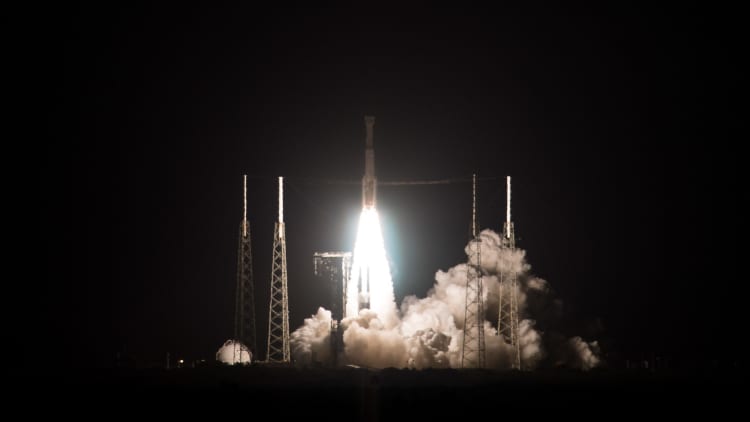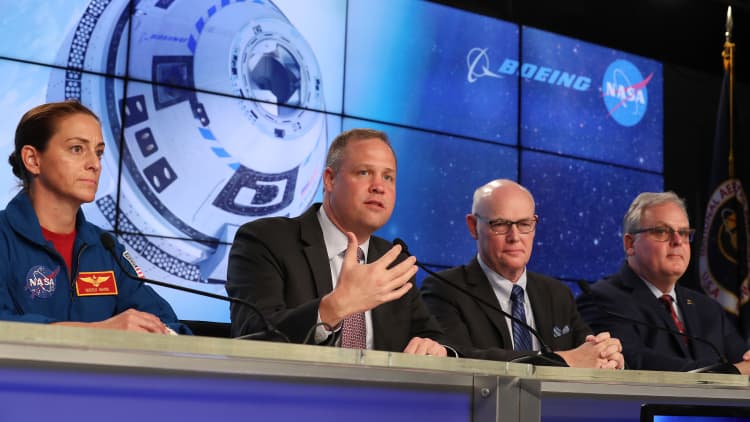
Boeing's spacecraft Starliner, developed to fly astronauts, failed to achieve the goal of its critical flight test for NASA, when it was launched to space on Friday.
Starliner was supposed to fly to the International Space Station, deliver cargo, and return safely – to demonstrate its capabilities and safety. But the spacecraft will not dock with the space station after its autonomous flight-control system misfired shortly after the launch, putting Starliner in the wrong orbit.
"When the spacecraft separated from the launch vehicle, we did not get the orbital insertion burn that we were hoping for," NASA Administrator Jim Bridenstine told the press in a briefing after the launch.
The spacecraft launched at 6:36 a.m. ET on top of an Atlas V rocket built by United Launch Alliance, a joint venture of Boeing and Lockheed Martin.
No one was on board Starliner, as this flight was intended to be one of the final tests before NASA flies astronauts. NASA has awarded Boeing nearly $5 billion to develop Starliner, which is built to carry as many as five people.
Boeing said it has been able to at least partially correct Starliner's trajectory in space, getting the vehicle to stable orbit around the Earth while engineers assess the options remaining for the mission. If astronauts had been on board, both NASA and Boeing believe they would be safe.
The company expects it will still be able to test many of Starliner's systems while the capsule is in space.
"There's probably an opportunity to practice spacecraft guidance and control, just not at the same proximity to the station that we previously thought," Boeing told reporters.

Bridenstine said in an interview with CNBC's "Squawk Alley" on Friday that NASA plans to land Starliner "in the coming days" in New Mexico at the White Sands military facility.
"It's too early to know" if the next one will have humans on board, Bridenstine added.
What went wrong with Starliner
NASA and Boeing have yet to identify the precise cause of Starliner's issue but Bridenstine walked reporters through what the partners know so far.
"It appears as though the mission elapse timing system had an error in it," Bridenstine said.
The mission elapse timing system is essentially Starliner's internal clock. It is crucial to telling the spacecraft's computers when and how to fire its rocket thrusters to reach the correct orbit.
"That anomaly resulted in the vehicle believing that the time was different than it actually was," Bridenstine said. "Because that timing was a little bit off, what ended up happening is the spacecraft tried to maintain a very precise control that it normally wouldn't have tried to maintain and it burned a lot of [propellant] in that part of the flight."
Boeing's human flight controllers tried to communicate with Starliner during the flight to correct the error. But the spacecraft was in a communication dead zone, a gap between two communication satellites.
"We couldn't get the command signal to the spacecraft that it needed to do the orbital insertion burn soon enough," Bridenstine said.
With no astronauts on board to take over manual control of the spacecraft, Bridenstine noted that part of the issue comes down to automation.
"What we were trying to do is make sure we could do this entire mission end-to-end completely automated and that didn't work," Bridenstine said.
Boeing has touted the amount of redundancy built into Starliner's autonomous system. But, as for the cause of the internal clock error, Boeing officials said they're still investigating the root cause.
"We don't understand why the spacecraft got off the mission elapsed time," Boeing said.
Boeing suffers another setback
Issues with Starliner come as Boeing grapples with the fallout from two fatal crashes of its 737 Max commercial jetliner, arguably the largest scandal in the company's history. The two crashes — which killed 346 people — have embroiled Boeing in a governmentwide review of its engineering practices as well as how the Federal Aviation Administration reviews aircraft. Boeing said earlier this month that it will suspend production of its bestselling aircraft at least through January as the FAA's investigation into the 737 Max continues.
This represents a blow for NASA as well, likely further delaying the agency's return to being able to fly its astronauts to the space station. Delays have plagued the commercial crew program, as NASA intended the first launches to happen as early as 2017.
Bridenstine briefed Vice President Mike Pence shortly after the incident, as Pence serves as the chair of the National Space Council.
"Pence was assured that NASA will continue to test and improve, in order to return American astronauts to space on American rockets in 2020," the vice president's press secretary said.
Since the end of the Space Shuttle program in 2011, astronauts have flown aboard Russian Soyuz spacecraft.
In 2014, NASA awarded development contracts for the commercial crew program to SpaceX and Boeing. Future commercial crew contracts would be up for grabs, as NASA would look to buy seats on Boeing's Starliner capsule and SpaceX's Crew Dragon.
— CNBC's Tom Franck contributed to this report.


